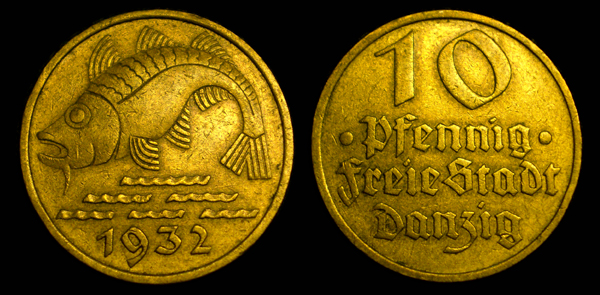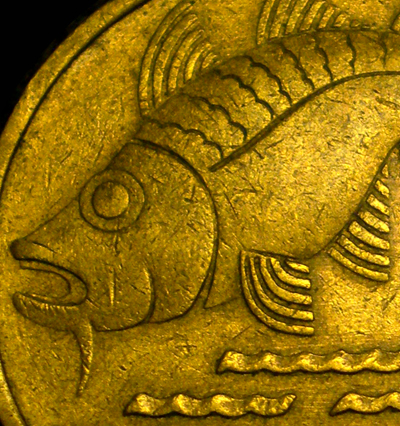
10 PFENNIG COIN - DANZIG - STYLIZED CODFISH
(KM 152)
Date: 1932
Obverse: Stylized codfish facing left with waves - Date 1932
Reverse: Denomination 10 Pfennig - FreieStadt Danzig
Engraver: Erich Volmar
This is a 10 pfennig coin issued by the Free City of Danzig in 1932. Although the city of Danzig has its roots in late antiquity, the Free City of Danzig was a semi-autonomous city-state that existed between 1920 and 1939 and included the port city of Danzig (Gdansk in Polish) and several hundred towns and cities in the surrounding area. The Free City of Danzig was more of a customs union controlled by commissioners under direct supervision of the League of Nations. It was created after World War I in compliance with Article 100 of the Treaty of Versailles. Although the population was primarily German, Poland was given generous rights and power of administration and representation of the territory as well as usage of the port as the free city was created primarily to give the newly created Polish state access to the Baltic Sea.
In 1939 Germany invaded Poland. The Battle of Westerplatte, where German forces along with Danzig police attacked a Polish military transit depot on the Westerplatte peninsula in the Danzig harbor, is considered the first battle of World War II. With a German victory, the Free City of Danzig was abolished and became a part of the Danzig-West Prussia administrative district. Under Nazi control the remaining Jewish and Polish residents were persecuted and eventually sent to slave labor or concentration camps. By the end of World War II, Danzig was mostly destroyed and the city was taken by Soviet forces on March, 30 1945. It had already been determined at the Yalta Conference in February of that year that the city would become a part of Poland. Those Germans who had not already fled the city were expelled and Poles from Eastern and Central Poland were resettled in Gdansk. After the war the city was rebuilt with an emphasis on purging any German influences and the city became a major soviet shipping and industrial center. Gdansk would become an important site for anti-soviet protests spurring the Soviet Union to launch Exercise Zapad-81. This was the largest military exercize in history, partly conducted near Gdansk, with the purpose of reminding those who sought to end soviet rule of the military might they would face. In the end, the communist regime collapsed in 1989 and Gdansk remains today a major and prosperous shipping port. |

